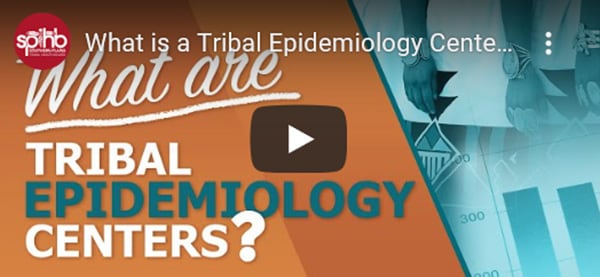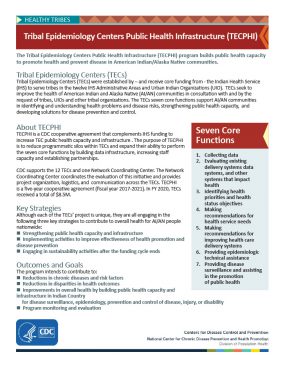Tribal Epidemiology Centers Public Health Infrastructure (TECPHI)

Routine disease and risk factor data for American Indian and Alaska Native (AI/AN) populations is often incomplete or missing in federal and state data, due to the relatively small size of these populations and widespread race misclassification. The Tribal Epidemiology Centers Public Health Infrastructure program is one example of the Centers for Disease Control and Prevention’s (CDC) approach to address this data gap and build public health capacity to promote health and prevent disease in AI/AN communities.
Tribal Epidemiology Centers (TECs) were established by, and receive core funding from, the Indian Health Service (IHS) to serve tribes in the 12 IHS administrative areas and Urban Indian Organizations (UIO). TECs seek to improve the health of AI/AN communities in consultation with and by the request of tribes, UIOs, and other tribal organizations. The TECs’ seven core functions support AI/AN communities in identifying and understanding health problems and disease risks, strengthening public health capacity, and developing solutions for disease prevention and control.
About TECPHI
TECPHI is a CDC cooperative agreement that complements IHS funding to increase TEC public health capacity and infrastructure. The purpose of TECPHI is to reduce programmatic silos within TECs and expand their ability to perform the seven core functions by building data infrastructure, increasing staff capacity and establishing partnerships.
CDC supports the 12 TECs and one Network Coordinating Center. The Network Coordinating Center coordinates the evaluation of this initiative and provides project organization, logistics, and communication across the TECs. TECPHI is a 5-year cooperative agreement (calendar years 2022–2027). TECs receive a total of approximately $6.8 million per year.
Key Strategies
Although each of the TECs’ project is unique, they are all engaging in the following three key strategies to contribute to overall health for AI/AN people nationwide:
- Strengthening public health capacity and infrastructure
- Implementing activities to improve effectiveness of health promotion and disease prevention
- Engaging in sustainability activities after the funding cycle ends
Outcomes and Goals
The program intends to:
- Reduce chronic diseases and risk factors
- Reduce disparities in health outcomes
- Improve overall health by building public health capacity and infrastructure in Indian Country for disease surveillance, epidemiology, prevention and control of disease, injury, or disability
Full list of TECs, Service Areas and Network Coordinating Center locations within the TECPHI program.
Funding totals for the Tribal Epidemiology Centers Public Health Infrastructure program.
 External Link Icon
External Link IconTribal Epidemiology Centers are organizations that serve American Indian and Alaska Native tribal and urban communities. They manage public health information systems, investigate diseases of concern, manage disease prevention and control programs, and respond to public health emergencies. They coordinate these activities with other public health authorities.
- Collecting data
- Evaluating existing delivery systems, data systems, and other systems that impact health
- Identifying health priorities and health status objectives
- Making recommendations for health service needs
- Making recommendations for improving health care delivery systems
- Providing epidemiologic technical assistance
- Providing disease surveillance and assisting in the promotion of public health
Printable summary sheet [PDF – 546 KB] of the Tribal Epidemiology Centers Public Health Infrastructure program at a glance.
